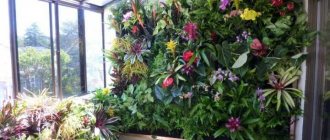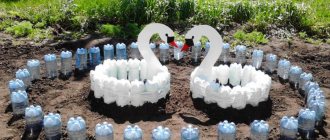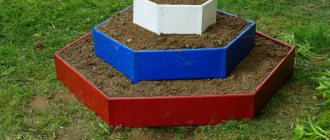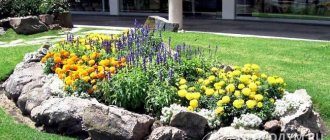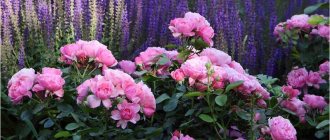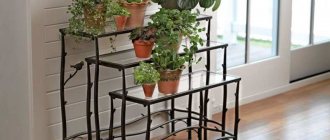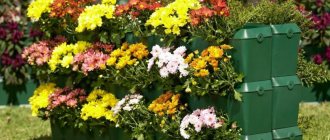DIY flowerbed
The flowerbed can be purchased ready-made or made with your own hands. The second option differs from the first in terms of budget. After all, making a flowerbed yourself from individual parts will be much cheaper than ordering a prefabricated version.
An example of a diagram of a round flower bed for a summer house
But this process will take longer. Creating a flowerbed with your own hands can be divided into four stages:
- thinking through the future structure and plants;
- choosing a suitable location;
- installation of fencing;
- planting flowers.
Everything is clear with the first stage. It is necessary to decide in advance what the flowerbed will look like, as well as what flowers will be planted in it. All other stages will depend on these decisions.
Scheme of a flower bed of annuals
Selecting a location
The choice of location for a flower bed depends directly on the preferences of the flowers that will bloom in the flower bed. If you plan to plant shade-loving plants, then it is best to place the structure next to an object that will create shadow. For example, next to a fence or large tree. By analogy with this situation, it is worth making a choice in favor of one place or another.
Flower garden for shady places in the garden
To make it easy to care for the flowerbed, it should be accessible from all sides. It is desirable that the free space between it and other objects be at least thirty centimeters in circumference, so that a person can calmly approach it.
Coniferous compositions
Tall conifers are unlikely to be suitable for a house flower bed, because...
an overgrown tree will block light, and the roots will not have enough free space. But compact junipers, dwarf varieties of fir, and neat thujas can be used to decorate a flower garden. Such flower beds are unpretentious and equally attractive at any time of the year. The most suitable option for a flower bed along the house is a horizontal composition. The basis is made up of plants of the same height. For low flower beds, mountain pine, Cossack juniper, Alberta Glob spruce are suitable, for higher ones - Lawson cypress, Compacta Glauka pine, etc.
If there is a task to block excess light or to cover the facade as much as possible from prying eyes, you can build a hedge from conifers. The task can be easily accomplished by thuja, which can be planted alone or in company with barberry.
DIY fencing for flower beds
The actual construction of a flowerbed with your own hands begins with the fencing, because it is this that serves as the basis for its design. There are a lot of options for its shape, but the installation principle is the same. The main function of the fence is to contain the fertile soil inside the flower bed. The decorative task is secondary, but equally important.
Fencing for flower beds made of bricks
According to the functional feature, the fence must completely repeat the shape of the flower bed; accordingly, it should be thought out first. The next step will be preparing the land. For easier installation of the flower bed, it must be leveled in advance. If this is not the case, then it is worth preparing a flat area, an area slightly larger than the size of the fence. It is enough to simply dig up the soil from the hills, scatter it over the holes, and then compact it all.
Fencing for flower beds made of boards
The next step will be the actual installation of the fence and its secure fastening. The service life and overall attractiveness of the structure will depend on the quality of the work done. If the fence is heavy enough and will be reliably supported by its own weight, then it is enough to place it on the surface of the ground. For example, from masonry. If its structure is less reliable, then the supporting structures should be immersed in the ground and secured there. Creating a fence for flower beds with your own hands is a very interesting experience. And with due diligence and a creative approach, a worthy flowerbed in the country will emerge.
Fencing for flower beds made of stone
Stages of creating a flower bed in the garden (step by step)
It is recommended to take time to create a design for future floral objects. This will prevent you from being disappointed in the future due to possible disharmony.
Sequencing
- Analyze a variety of illustrative material using printed and electronic publications on landscape design.
- Determine your preferred color scheme. The further acquisition of flower seeds depends on this.
- The location of flower beds is chosen depending on the characteristics of the plants. If they love light, then place the flower beds away from trees and tall buildings.
- Provide an approach for providing care. Shade-tolerant crops will be comfortable near walls and fences. They mark the entrance to the site. Often planted next to the gazebo or in tree trunks.
- They think about the configuration, the presence or absence of decorative fencing. Create a scale diagram of the site and draw all the planned flower beds on it. Make sure to make a plan in color, which will allow you to correct unsuccessful combinations if necessary.
Each flower bed located in this beautiful and fabulous garden evokes genuine delight and tenderness.
A classic design option for a flower bed near the house
Blue spruce looks great surrounded by beautiful flowers
Which plants to choose
In the process of creating flower beds that organically fit into the overall style of the landscape, it is necessary to be guided by several principles.
Rules for arranging flower beds
- Plants are selected in a contrasting or harmonious combination of similar colors, taking into account not only the color of the petals, but also the shape and size of the plant.
- It is not recommended to create excessive spice. Usually no more than four varieties are placed in one flowerbed. The height of the selected flower crops is taken into account, placing low-growing varieties at the forefront.
- The highest aerobatics of landscape art is considered to be the provision of a continuous change in the color background, thanks to the planting of varieties with different periods of bud formation.
Giving preference to perennials, they turn to zoned varieties that can withstand the winter seasons without damage. Plants such as clematis and peonies can grow without replanting for several decades, delighting with abundant flowering.
Beautiful arrangement of flowers near the house in two tiers
A real riot of colors in the backyard of a private house
A cozy retreat with incredible beauty in your own garden
On a note! The advantages of perennial flowers also include easy care and low financial costs, since there is no need to purchase new seedlings every year.
Among modern trends, several color options for flower beds attract attention:
- Monochrome . Involves the selection of shades of different saturations of the same color. This group also includes plants with decorative foliage, the variety of which varies from silver-green, ant, malachite, lemon to pearl tones.
- Green and white combinations . To create such a fresh sound, primrose, peonies with white inflorescences, and hydrangea are planted. Mock orange and spirea add charm to the site.
- Green-pink version . Chrysanthemums, clematis, charming roses, and astilbe create unusually delicate and imaginative tints in this range. You can plant decorative barberry and bergenia.
- Monoformity . It involves placing varieties that have a single shape in one flower bed. An interesting option is the round crown. For example, blue fescue, standard roses, and large-leaved hydrangea are planted. The spherical thuja adds charm and amazing grace.
- Contrast . To solve such a problem, which involves an unusual, very bright sound, flowers are planted that have, for example, yellow and purple colors. Burgundy and blue buds create a striking contrast. A fashionable option remains the blue-yellow combination, for which irises of different varieties, viola, delphinium, and daylily are suitable.
A beautiful and well-groomed flowerbed near the house with a natural stone fence
From low plants of various shades it is possible to lay out bright ornaments reminiscent of an expensive carpet
Nothing decorates a summer cottage more than the presence of beautiful flower beds and flower beds
Classic low flower bed
The standard solution remains a low round flower bed on which flower crops selected according to a specific plan are placed.
For marking, use a rope, which is tied in the center of the future structure and with the help of a peg, a circle is drawn on the other edge. Select soil to an average depth of 25 cm, while trying to completely level the surface.
Advice! To protect the plantings from difficult-to-eradicate weeds, the mole cricket and the bottom of the excavation are lined with geotextiles.
Carrying soil with a wheelbarrow is simple and convenient
If the soil on the site is heavy loam, then additional gravel drainage is placed, creating a layer about 7 cm high. Then a soil mixture is prepared, combining the excavated soil and rotted compost. At the same time, phosphorus-potassium fertilizers are added, calculating that 25 grams of this drug will be required per square meter.
The prepared soil substrate is laid out on a drainage pad so that the edges of the future flower bed are raised above the ground surface. If necessary, decorative fencing is installed to protect the embankment from being washed away by rain and giving it a special decorative effect.
When planting flowers in a flowerbed, it is important to provide them with the most comfortable conditions possible.
Planting
The soil for planting in a flower bed must be prepared in advance. You can remove the fertile layer from another piece of land and cultivate it, or purchase ready-made soil. The soil inside the flowerbed should not contain any weeds, as they will crowd out the planted flowers. It should also be fenced off from the general soil of the site so that nothing from it gets inside.
Ready flowerbed for planting flowers
The flowers in the flowerbed must clearly correspond to each other, forming a single composition. At the same time, the life cycle and time of their flowering must coincide. A proper combination will allow the flower bed to smell fragrant and be amazingly beautiful.
Flowers in a flowerbed should form a single composition
You need to plant flowers in a flowerbed at a certain period and choose the right combinations so that flowering begins at the same time. You also need to focus on the overall composition; the plants should look harmonious with each other.
Before planting flowers, the soil can be fertilized to speed up the establishment of plants. Natural ingredients such as humus, compost or ash are preferred. But chemical fertilizers, which are sold in flower shops and agricultural departments of large stores, are also suitable.
Flowerbeds need regular fertilizing
If the flowerbed is deep, then it is not necessary to occupy its entire volume with a fertile layer of soil. Alternatively, fill the bottom with ordinary soil.
Sometimes flower beds are built in the reverse order, that is, they first create an elevation from a layer of soil, and then secure it by erecting a fence. Fundamentally, there is no difference between these methods; it’s just that for some flower beds the reverse method is more preferable.
Peonies
Peonies are distinguished by lush, delicate inflorescences and bright foliage, so they feel self-sufficient in solo compositions. The variety of shades allows you to fit flowers into the space next to your home as succinctly as possible. For a bright façade, white, pale pink or cream varieties are suitable. Juicy raspberry, burgundy and scarlet peonies will help revive the unsightly exterior.
Possible shapes for flower beds
Flowerbeds can take almost any shape due to the versatility of fencing construction. It is not necessary to make a design in the classic shape of a round vase or a rectangular planting; you can decorate your summer cottage garden with something much more elegant.
Mesh flowerbeds
A rather original solution would be to build a flower bed with a fence made of building mesh. This design is quite easy to implement and looks as non-standard as possible, and also has great variability.
Types of fences for flower beds made of chain-link
Consider the option of making a round flower bed. The first step is to create a frame. To do this, take two meshes, identical in height, but differing in length. After this, they are rounded and securely fastened with metal links. It would be optimal to select the length of the meshes so that the difference in their radii (the distance between them in a straight line directed towards the center of the structure) is approximately eight centimeters.
Round flowerbed for a summer house made of mesh and stones
Afterwards, the frame is securely buried in the ground and filled with stones. For this purpose, you can collect small cobblestones that are scattered around the area. Medium-sized river stones can also be an interesting filling, the main thing is that they are larger in size than the grid cells. After this, the fence will be ready and, if securely fastened, will last a long time. Now you can start filling the newly made flowerbed with soil and planting flowers.
A flowerbed at the dacha made of mesh and stones is durable
A more complicated version of such a fence would be the production of a multi-level frame. To do this, you should select two such networks, which in height will reach the maximum size of the flower bed, and then convert them into stepped ones. So that they gradually increase in height from the bottom of the flowerbed to the very top.
Flowerbed in the country with a multi-level frame
The rest of the construction of the fence is similar to the simple version, but it is worth closing the vertical gaps that arise so that the stones do not fall out of them. The best option for this would be to use the network elements remaining after cutting, and then weld them to the main structure, or securely fasten them with a wound rope.
The soil in such a flower bed will be laid gradually, to create the shape of a gradually rising hill.
Such a solution will highlight your site for the better. After all, a flowerbed made from construction mesh is distinguished by its unnaturalness and unusualness. And its multi-level version resembles a spiral staircase, and few people have ever seen such a design.
Flowerbed at ground level
Instead of growing the flowerbed in height, you can deepen it underground. This design option will most closely resemble a flower garden, but will still be different from it.
To build such a flower bed, you need to pay special attention to soil preparation. To begin with, it is worth clearly demarcating the territory, and then digging out all the earth from there. The depth of the hole is not important if there is fertile soil under the hole, but if not, then it should be larger than the size of the root system of the flowers, which will then be planted in the flowerbed. Since the fertile layer is obtained, it should be carefully folded in a certain place on the site, and then treated to remove weeds.
Flowerbed at ground level for a summer residence
After the area for the flowerbed at the dacha has been dug, it is necessary to level its boundaries where the fence will be installed. It is not necessary to make the entire area level. The fencing material can be anything that is sufficiently reliable. If decorative stone or something similar is used, it is best to cement the joints. The height of the fence in such a structure should correspond to the ground level.
Flowerbeds at the dacha at ground level, lined with stones
The final stage will be returning fertile soil to the flowerbed, planting flowers and improving them.
This design is more complex in execution, but has a special style and will look interesting next to the lawn.
From improvised means
A flower bed made from scrap materials is the simplest to make and the cheapest. An easy option would be to use an old tire. You just need to clean it, place it in the most suitable place, fill it with fertile soil, and then plant flowers in it.
Multi-level flower bed made of tires
A more advanced option would be to use several tires as a fence to the flower bed. First, they need to be washed, then cut crosswise in half and buried so that the inner rim touches the ground. Then she won’t wake up through the tires, they will hold her back. The tires can be painted in a color that will harmoniously fit into the overall composition of the plants.
Fencing for flower beds made of tires
Instead of tires, you can use tires, old stumps, boards and many other scrap materials.
You can also change your approach to creating flower beds with your own hands. For example, instead of several abundant ones, place many small ones throughout the dacha, completely different in composition.
Composition of several flower beds on the site
In addition to the listed options, there are many others, the use of which can best fit into the exterior of your summer cottage.
Types of fencing
For fencing in flower beds, not only special store-bought materials are suitable, but also improvised means that would seem to belong in the trash heap. These include, for example, ordinary plastic bottles, with the help of which it is easy to organize a low barrier that will last for many years.
It is worth noting that glass types of bottles can also be used. Craftsmen also make tall flower beds out of them, which look extremely impressive; besides, you can’t immediately guess that simple bottles were used.
The only thing you will have to worry about is finding a large number of these unique interior items, and they must be of the same shape for such a fence to look beautiful.
Ordinary unnecessary tires are often used for flowerbeds, which, for example, can be painted in your favorite color. Flower beds that consist of several tiers look great from them; sometimes they are hung, which also looks unusual and pretty, especially if you add bright flowers.
You can use other old items, it all depends on the imagination of the summer resident.
Flower beds at the dacha
A flower garden is a more general concept than a flower bed. It becomes any place where plants are planted, not only flowers, but also shrubs. It also lacks a clear boundary. The combination of all these factors gives greater diversity.
A flower garden differs from a flower bed in the absence of clear boundaries
The main advantage of a flower garden is the possibility of spreading it everywhere. Its plants can be planted anywhere, from an old stump to a rocky wall. It turns out that any arrangement of plants automatically becomes a flower garden.
Rose garden
Fans of climbing roses often strive to decorate one of the walls of their home with them. In order not to fill the foundation, a blind area 50-70 cm wide is made in advance. For young roses, supports are installed from small trellises, and over time the fastening is transferred to the facade.
Ground cover varieties of roses can also be safely used for a flower garden near the wall. They grow quickly, bloom profusely, and the aroma will be heard not only in the garden, but also in the house. When choosing roses for a site, it is important to pay attention to several characteristics:
- Frost resistance;
- Duration of flowering;
- Growth rate;
The last criterion allows the bushes to recover faster after a difficult winter.
DIY flower garden
For a flower garden, first of all, you need to choose a planting location, as well as a composition of plants. Afterwards, you should prepare the soil by leveling and cultivating it. The final part will be planting the plants. The general principle is exactly the same as installing a flower bed, with the exception that you don’t have to worry about installing a special fence.
Flower garden diagram for a summer residence
Original photo ideas for decorating round flower beds
The design of a round flower bed sometimes brings in indescribable delight and admiration. Below are some of these masterpieces.
I would like to immediately note that here are most of the examples of decorating a round flower bed with annuals, but in these situations I want to emphasize not a set of flowers, but a highlight.
A small bridge invites you to walk along it and stop in the middle of a sea of flowers:
Such a carriage will become a source of pride for any dacha owner:
Not a single fashionista will refuse such a hat in her area. And making a round flower bed for flowers of this shape is not at all difficult:
Flower clocks are no longer uncommon in garden design. However, this color combination especially attracts attention:
The flowerbed would be rather inconspicuous if it were not for such an interesting structure:
An ordinary cut of a stump, and against its background a stylish flower bed:
Another interesting decor for a round flower bed. An example of how you can decorate a flower garden using decorative wood chips:
An example of how you can decorate the space around a round flowerbed with stone:
And here is the design of a round flower bed of perennials. Lavender, euonymus, stone and infinity of taste:
A hedge for framing is a classic of parterre gardens:
Varieties
There is no generally accepted classification of flower beds, but there are several names that are used most often.
Border
This flower bed is used as a decorative fence. Its width usually does not exceed sixty centimeters, and matching flowers and shrubs are used as decoration; both longitudinal and transverse symmetry are preserved.
Flower garden-border at the dacha
Mixborder
In structure and size, this flower garden is similar to the “border” type. Most often it is installed at the junction of the path and walls. This flower bed has no transverse symmetry; it seems to separate this joint.
Mixborder flower garden at the dacha
Parterre
It is also called an ornamental flower garden. The flowers on it are arranged in a certain order and form a pattern, generally large in area. Used as decoration.
Graphic flower garden parterre at the dacha
Rabatka
This is a variation of the parterre flower garden, but with a more defined size. It is generally accepted that its width varies from half a meter to three meters, and its length is three times or more than its width. If the ridge flower bed is located near the wall, then the plants are planted in ascending height. And if you can inspect it from all sides, then the tallest plants and shrubs are planted in the center, and from them the lower ones are located at levels.
Flower bed scheme discount
Roccary
This is a flower garden in which special attention is paid to additional elements. The basis of the composition in it are large stones, which can lie either evenly and structured, or in a chaotic, natural order. Together with them in the flower garden there are small plants: creeping, climbing and heather shrubs. And also many others that are suitable in general style and whose growth is possible in such a flower garden.
Picturesque flower garden rockery
Important details when forming a flower bed
Before you make a beautiful flower bed, you need to draw up the most detailed plan, which is considered landscape. Without it, there is a high probability of bad taste appearing on the site.
You can draw up such a plan yourself using the example of similar sites that are easy to find on the Internet, spending a little more time on it, or contact those who specialize in this type of design, then the result will be of higher quality and in a shorter time.
Interesting ideas for a flower garden
The main advantage of a flower garden is its general unlimited shape. Using improvised means you can complement the composition. For example, in the center of a flower bed on a small hill, install a tire, inside of which a climbing plant is planted, and wrap its stem around the tire. By analogy with this, you can come up with an infinite number of variations. Below we will present several rather unusual solutions.
Butterfly flower garden
For large summer cottages, a flower garden in the shape of a butterfly on the lawn may be suitable. Its overall shape will be rectangular, with green grass planted at the corners. But in the center there will be an interesting composition of the body, head and wings of a butterfly. The shape of the composition is given by a variety of colors and their overall palette. Let the boundaries of the wings be outlined by identical plants. The rest of the terrain will be marked by a variety of colorful flowers, as well as miniature shrubs.
Flower garden at the dacha in the shape of a butterfly
An interesting improvement to such a flower garden would be to add volume to the composition in addition to shape. For example, the head of a butterfly can be made higher than its body by raising the ground level in the corresponding area.
Volumetric flower garden in the shape of a butterfly
This flower garden belongs to the “parterre” type.
Miniature flower suspension bridge
Due to the fact that the flower garden does not have a clear shape, you can depict anything. A rather interesting solution would be an overhead structure in the shape of a bridge, on which flowers will be planted.
First of all, it is necessary to manufacture and install the structure frame. It will have a curved shape. The most effective option would be to build a wooden stepped structure, small in size and height. Sides should be installed at its borders to prevent soil from falling out.
Original flower garden-bridge at the dacha
The final step will be to fill the “bridge” with fertile soil; it is advisable to do this in such a way that a smooth hill is formed. Afterwards you can start planting plants in the ground. Small flowers are best suited for this, the root system of which will not exceed a layer of fertile soil. At the borders of the territory, you can plant plants that will cover the sides.
Building such a flower garden is a very difficult task that you will have to tinker with. But it will also look appropriate; a hanging bridge decorated with flowers will appear on your site. Such a flower garden will be a stunning decorative element of any dacha. Plus, it won’t take up much space, and shade-loving plants can be planted under it.
The type of this flower garden is difficult to determine.
Rose garden
The rose garden is a flower garden in all its splendor. It is composed mainly only of roses of different colors.
Flowering of these plants occurs better in a illuminated area. The flower bed location should have direct access to sunlight. It is advisable that no objects shade it. However, roses need protection from drafts. It is best to choose a contrasting color scheme.
Luxurious rose garden in the country
For an amateur gardener, a similar rose garden structure is suitable: the flower garden is located on the south side of the site, surrounded on three sides by deciduous trees that will not cast their shadow on it. As an interesting combination, you can take decorative varieties of white, red and purple flowers.
An option for decorating a rose garden is to add secondary flowers, less bright ones, that will complement the main ones.
Roses are very finicky, require a lot of care and are highly dependent on weather conditions, but a blooming rose garden will be worth the effort. Creating such a flower garden with your own hands will advantageously decorate your summer cottage plot against the background of others.
The rose garden needs regular careful maintenance
"The queen is decorated with a retinue." In addition to roses, you can place other types of flowers in the flower garden. Lavender, cloves and iris are best suited for this. Their task is to complement the beauty of roses, and not to set them off. Therefore, there should be much fewer additional colors than the main ones.
The rose garden is a separate type of flower garden and is very popular due to its external features.
Features of an independent approach to the plan
You should not emphasize any of the corners of the site; there should be a uniform load of color background. Otherwise, one of the corners will be empty, and such an area will not look harmonious.
Its size is also of great importance, since a small number of design elements should be placed in a small volume, since there should be free space. The presence of flower beds should complement the recreation areas, and not create the effect of crowding, as in a wholesale flower base.
When planting flowers, it is worth considering climatic conditions. A flower garden should please summer residents in any month they are on the site, so it is worth being puzzled by this pattern when planting flowers.
There are plants that do not shed their leaves for a long time and remain with foliage, so it is recommended to supplement flower beds with them.
Differences between a flower bed and a flower garden
It was already mentioned above that a flower bed is simply a type of flower garden. Accordingly, it cannot be said that one option for decorating a summer cottage is more acceptable than another. They are just different and suitable for different tasks.
If you are interested in decorating a certain piece of land that you want to clearly fence off, planting it exclusively with flowers, then a flowerbed in your country house is suitable for you.
A flower bed differs from a flower garden in its clear shape
In case you want to create a composition from various plants, including small shrubs. If, in addition to the form, you need to add volume to the combination, as well as additional decorations. In this case, the best decoration for you will be a full-fledged flower garden in the country.
Lush flower garden at the dacha
Both options will look good on the site. The only difference will be in the complexity of execution and subsequent care. It doesn’t matter what you choose, a flowerbed at the dacha or a whole flower garden, any decorative element will add its own, unique style to the area. And creating various combinations will be an excellent way to realize your creative potential.
Mixborders
If you want everything at once, you should give preference to a mixborder. Here compact shrubs coexist with perennial flowers and ornamental grasses. Flowerbeds are multi-row and multi-tiered. Flowers are selected so that the decorative effect of the composition is preserved from early spring until the first frost.
When choosing seeds and seedlings for decorating a flower bed along the wall, you should pay attention to plants with beautiful, lush greenery. They will decorate the area even during breaks between flowering.
Photo gallery - flower garden, flower bed at the dacha
Figures for the dacha made of polyurethane foam
How else can you decorate your summer cottage? Interesting crafts that deserve attention are made from polyurethane foam. Using polyurethane sealant, you can make funny little animals: snails, buns, hedgehogs, and then paint them with acrylic paint. For large crafts, for example, a horse or a roe deer, you will have to prepare a frame, which is made from plastic bottles and strong wire. Believe me, such a handmade craft will definitely attract the attention of guests of your site.
Foam figures for the garden
Crafts from polyurethane foam and tires photo
Crafts from polyurethane foam photo
